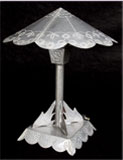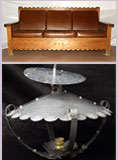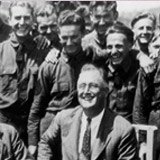|
|
|
|
 |
 |
|
Franklin Delano Roosevelt’s Works Progress Administration [WPA] provided jobs for the unemployed during the Depression. The Civilian Conservation Corps [CCC] was a major component of the program. Desperate for food, honest work and a way to support their families, over three million men joined the CCC between 1933 and 1942. They planted trees, built roads and dams, constructed lodges and museums, and hand crafted furniture. This peacetime army built character, taught discipline, provided financial stability, and prepared many for World War II.

Civilian Conservation Corps Camp No. 815 in Frijoles Canyon opened in November 1933. Economic hardship brought hundreds of men between the ages of 18 and 24 to Bandelier. Paid $1 a day, the young men welcomed the opportunity for training, room and board.
|
|
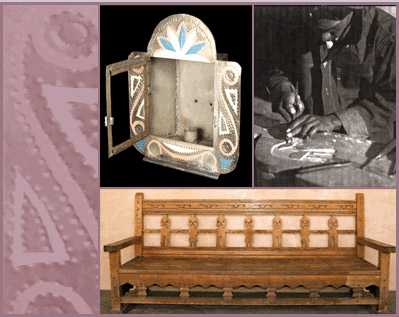 |
| Until the 1930s the canyon bottom and a small lodge were only accessible on foot or on horseback. Between 1933 and 1941, CCC crews built the road into Bandelier and buildings still in use today. Lyle Bennett, a Park Service architect, designed the buildings to harmonize with the nearby ancient structures and surrounding mesas. Frijoles Canyon Lodge, residences, offices, the fire tower and entrance station were made of hand-cut local stone.
The Bandelier Pueblo Revival-style complex has thirty-one buildings and a road, the largest collection of CCC structures in the National Park Service. The enrollees also made furniture and light fixtures, and worked on trails, landscaping, and archeological preservation.
|
|
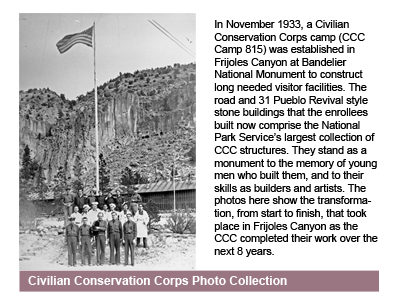 |

Bandelier tinwork continued an old New Mexican tradition. Delicate pierced and painted tinwork first flowered in northern New Mexico in the 1850s. During this period, American merchants sold canned goods to the army. Inventive Spanish-speaking artisans re-used the metal that had been rare before the military arrived.
At Bandelier, older, skilled workers taught the enrollees tinwork, furniture making, carpentry, carving and masonry. Designs were done on paper before the actual work began. Templates were used for repeating motifs. CCC craftsmen created wooden bed frames, dressers, chairs, stools, benches, and couches, as well as carved beams, corbels, and built-in shelves. They made tin table lamps, hanging light fixtures, and mirror frames. Designs incorporated Southwestern motifs, including the wild turkey design, scallops, wheels, sunbursts, rosettes, angles, and curves. Some were highlighted with paint. Tin chandeliers, wall sconces and wooden furniture are still in use at Bandelier National Monument.
|
|

